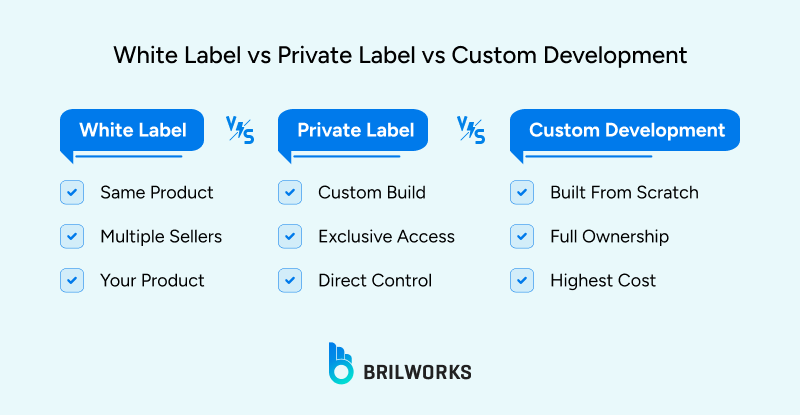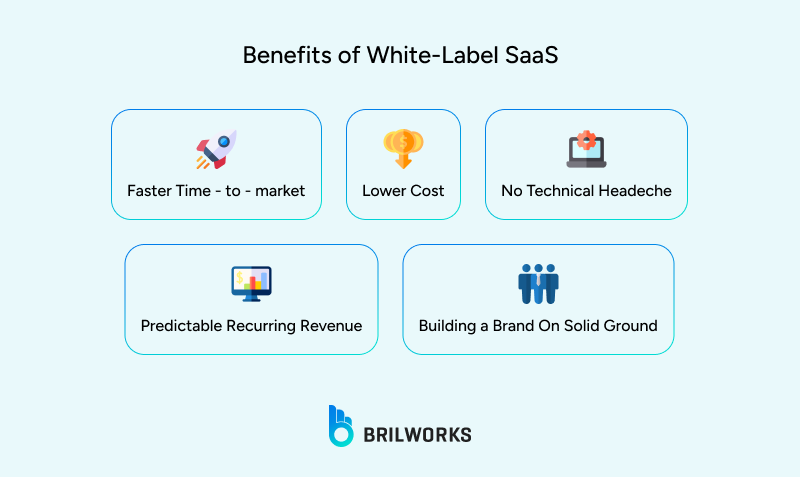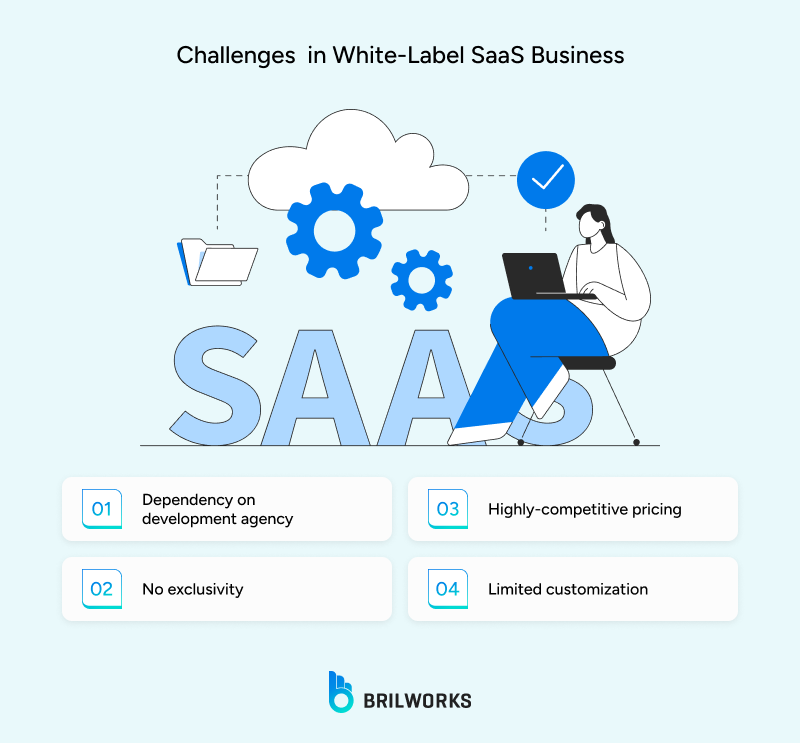COOPERATION MODEL
ARTIFICIAL INTELLIGENCE
PRODUCT ENGINEERING
DevOps & Cloud
LOW-CODE/NO-CODE DEVELOPMENT
FRONTEND DEVELOPMENT
CLOUD DEVELOPMENT
MOBILE APP DEVELOPMENT
LOW CODE/ NO CODE DEVELOPMENT
EMERGING TECHNOLOGIES








In the past, starting a software company meant you had to write code yourself or hire developers someone who could. That stopped many ideas from ever leaving notebooks or late-night notes apps. Even a basic SaaS product can take months to build, with constant changes and costs that most small businesses can’t afford.
White-label SaaS changed this. Now, people who know their customers well can enter the software market without needing to code. Instead of starting from scratch, you begin with a working product. You customize it for your audience and build your business around it.
Agencies, consultants, and solo founders can now run their own software brands without hiring development teams. This guide explains how the model works, why it’s worth considering, and what to look out for if you want to start a white-label SaaS business in 2025.
People often talk about “white-label SaaS” like it’s complicated, but it’s actually simple. One company creates the product, and another company sells it under their own brand.
The provider manages everything technical, like development, hosting, maintenance, and updates. The reseller focuses on branding and pricing. The development company builds the technology, while the reseller handles everything customers see.
White-label is often confused with private-label or custom development, but there are differences. With white-label, the same unbranded product can be sold by many resellers.
You can add your logo, colors, and pricing, but the core product stays the same. Private-label is more exclusive. In that case, a white label software development company builds a custom solution, and the client works directly with the development team.
Each method fits different businesses. White-label is best when you need speed and want to save money, rather than create something original. It’s a smart choice if your strengths are in marketing, sales, and customer support, not software development.
If you’ve run a business for a while, you know growth often stalls because of limited capacity, not a lack of customers. You can only handle so many clients before you run out of time or resources. White-label SaaS changes this by letting businesses, especially agencies, scale up without adding more work or hiring developers.

Markets move quickly now. With white-label development, you can go from idea to launch in days instead of months, skipping the development delays and testing your market right away. For startups and agencies, this is a big advantage. You can quickly test ideas, make changes based on feedback, and grow what works, all without spending a lot on engineering.
Developing your own White-label SaaS product costs anywhere from tens to hundreds of thousands of dollars. And that’s before updates, servers, and maintenance. A white-label software provider spreads that cost across all resellers, so you pay a manageable subscription instead of building from scratch.
With a white-label SaaS model, the software development agency handles technical nuances. You spend less time worrying about technical problems and more time focusing on your customers. You may not own the technology, but you do own the customer relationship. That’s what matters most to your clients.
Let’s walk through the practical steps.
Start with people, not software. Too many resellers begin by picking a platform and then trying to find an audience. It works better the other way around. Talk to your existing clients or communities you understand well. What do they keep struggling with that a simple tool could fix?
For example, local businesses might need a way to manage bookings, or small agencies might want an affordable CRM. These common problems are great SaaS opportunities. Once you find one, the right white-label software often becomes obvious.
Your white-label SaaS provider becomes your silent business partner. Their product quality, uptime, and support will shape your reputation, so choose carefully.
Look for:
Consistent updates and active development
Flexible branding options (domain, colors, custom emails)
Real human support, not just a help center
Solid integrations with tools your clients already use
A good provider does more than give you software. They help you build a business around it.
Branding is more than just adding your logo to a dashboard. Every detail, from the login screen to onboarding emails, should reflect your brand. Most white-label SaaS platforms let you customize visuals, domains, and automated messages. Take the time to personalize these details. They build trust faster than you think.
Pricing is where many new resellers trip up. Don’t try to be the cheapest. Customers don’t buy white-label SaaS products because they’re cheap; they buy them because they solve a problem cleanly.
Start by understanding what that solution is worth to your audience, not just what others charge. Then pick a pricing model that matches your service:
Subscription-based for steady, predictable revenue
Tiered plans if you serve different customer sizes
Usage-based if the value scales with activity
Make sure to leave room for healthy margins. A range of 40 to 60 percent is common, depending on the level of support you offer.
Your marketing doesn’t have to be fancy; it just needs to be clear and specific. Create a simple website that explains the problem your white-label SaaS solves and what makes it unique.
Use content, SEO, and social proof to earn trust. A few early testimonials often do more than any ad spend.
If you already have an agency, begin with your current clients. They trust you, so this is simply another way you can help them grow.
Once you launch, stay close to your users. White-label doesn’t mean hands-off. Ask questions, track what confuses them, and share that insight with your provider.
The best SaaS resellers use feedback as product research. They improve onboarding, adjust pricing, and update their messaging as they learn.
Customer retention is the real growth engine. Keep people happy, and your revenue compounds naturally.
White-label SaaS is great because it’s so flexible. You aren’t limited to one industry or business type. The same approach works whether you help restaurants with bookings or agencies with campaign management. The key is finding a market that values simple, effective solutions over complicated technology.
Here are some areas where white-label SaaS businesses are thriving, and the reasons behind their success.
You can offer a bundle of white-label marketing software that covers everything from lead tracking to automated email campaigns.
Every business has internal tasks that eat up time — project management, client communication, scheduling. White-label productivity platforms fill those gaps.
Resellers often offer these as client portals, dashboards, or workflow tools. For example, a web agency might provide a branded portal where clients can track progress, view invoices, and share files. It’s more than just software; it creates a smoother experience and strengthens your client relationships.
The deeper you go into a specific market, the less competition you face. A generic CRM may have hundreds of rivals, but a CRM built for real estate or fitness coaches can stand out fast. That’s why niche white-label SaaS platforms are gaining attention. Providers now offer specialized tools for areas like:
Healthcare: secure client communication or appointment booking tools that meet compliance standards.
E-learning: course management and progress tracking software that trainers can resell under their own name.
Cybersecurity: white-label VPNs and password managers for tech consultants building privacy-focused services.
When you focus on a specific audience, you’re not just selling software. You’re offering real understanding, and people are willing to pay more for that.
A growing number of white-label SaaS providers are adding AI-powered products: chatbots, analytics dashboards, content generation, or recommendation systems. They’re high in demand because they solve daily problems quickly and require no setup from the end-user.
Don’t follow trends without thinking. Choose a niche you know well. It’s much easier to customize, market, and sell when you understand your audience. White-label SaaS is about insight, not just software.
White-label SaaS might seem easy at first: you get a ready-made product, add your branding, and earn recurring revenue. But once you begin, you’ll face some challenges. The good news is that most issues are predictable, and you can plan for them.
Let’s go through the common challenges and how to handle each one.

Your white-label SaaS provider is your foundation, but that also means you depend on them. If they stop updating the software, change their pricing, or have downtime, your business feels it too.
To reduce this risk, choose providers with transparent development roadmaps and active support communities. Keep backups of your customer data and understand the migration options before signing up. A little homework now saves a lot of panic later.
If you’re selling a white-label CRM or a white-label marketing platform, chances are someone else is selling the same product with different colors.
That’s why your advantage isn’t just the tool itself. It’s how you package, position, and support it.
Focus on a narrow niche or a specific pain point. Customize onboarding, create tutorials in your voice, and offer hands-on help. People remember service, not dashboards.
Many new SaaS resellers set low prices to attract clients. This might get attention at first, but it often brings in price-sensitive customers who leave as soon as they find something cheaper.
Instead, price based on value. If your version of the product includes training, setup, or consultation, make sure that’s reflected in your pricing. You’re not selling just access; you’re selling an outcome.
You can’t always decide what gets built next. Most white-label software platforms evolve at their own pace, and that can be frustrating when your clients ask for new features.
To manage expectations, be clear with customers from the start about what can and can’t be customized. Collect their feature requests and share them with your provider, since many providers use reseller feedback to plan updates.
Even if the software works perfectly, clients will still reach out — login issues, confusion about settings, forgotten passwords. These can eat up time fast.
Set up a clear support process from the beginning. Use chatbots or ticketing systems, and create a simple help guide with your branding. The goal is to make it easy for users to solve problems on their own.
Selling a white-label SaaS business isn’t a one-time effort. You need steady marketing to keep getting leads, using things like SEO content, case studies, and social proof. Many resellers lose momentum after launch because they see marketing as a short-term project instead of an ongoing habit.
Plan ahead: dedicate time each week to post updates, share insights, or publish short guides. The more visible you are, the more credible your product looks.
The white-label SaaS model has quietly moved from a side opportunity to a serious business path. What started as a shortcut for agencies is now a core strategy for entrepreneurs, consultants, and even enterprises looking to expand without full-scale development.
But things are changing quickly, influenced by how businesses buy software and how technology is developed.
A few years ago, reselling meant working around whatever the provider offered. Now, no-code white label development tools are letting resellers customize dashboards, workflows, and even features without touching a line of code.
This flexibility makes white-label software much more powerful. Instead of using one-size-fits-all platforms, you can now offer tailored solutions for specific industries, like healthcare CRMs, property management tools, or e-commerce automation suites, all built from modular SaaS components.
We’re also seeing AI quietly reshape the SaaS landscape. From automated reporting to personalized recommendations, AI features are what clients increasingly expect as standard.
White-label providers are adding AI features to their products, such as chatbots, smart analytics, and content tools that adapt to user behavior.
For resellers, this means your white-label SaaS business can stay relevant without needing a data science team. The smarter your platform looks, the stronger your brand authority becomes.
The era of 'one tool for everyone' is ending. Buyers now want specialized solutions that fit their exact workflow. This has led to the rise of micro-SaaS, which are small, focused tools designed for specific problems.
Expect to see more white-label micro-SaaS platforms in areas like:
Local marketing automation
Subscription analytics for small creators
Client dashboards for consultants or agencies
These products may not reach millions of users, but they build loyal customer bases and provide steady recurring income.
As competition grows, providers are realizing their success depends on how well their resellers perform. The best ones now offer marketing materials, sales enablement kits, and white-glove onboarding.
This trend will continue, and the future of white-label SaaS will look more like a network of partners than a simple supplier chain.
With growing awareness around data use and privacy laws, white-label SaaS businesses will need to stay transparent. Expect stronger compliance requirements like GDPR, HIPAA, and regional hosting options to become standard expectations.
This will help resellers who can clearly communicate trust. Security and compliance will become key selling points, not just technical details.
Starting a SaaS company from scratch requires time, skill, and money. But the white-label SaaS model offers a different path, one that relies on resourcefulness rather than just technical skills.
It lets you focus on what really drives success: knowing your customers, branding well, and solving real problems consistently. You don’t have to invent the next big product; you just need to deliver something useful in a way that feels personal and reliable.
For agencies, freelancers, and entrepreneurs, this model can be the fastest route into recurring revenue and product ownership without starting from zero.
But the key is to treat it like a real business, not just a shortcut. Learn your product, improve your offer, and stay connected to your users. That’s how you turn white-label software resale into a lasting brand.
Get In Touch
Contact us for your software development requirements
Get In Touch
Contact us for your software development requirements